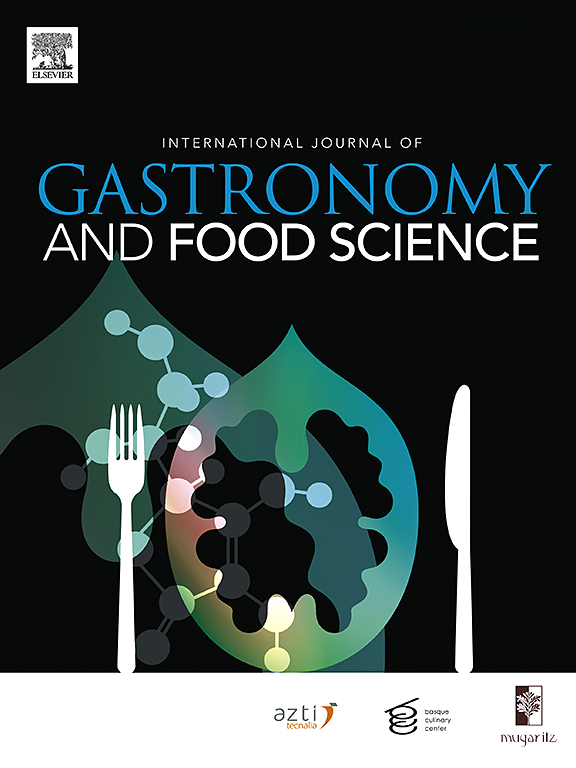墨西哥科利马传统菜肴的消费趋势:人口特征和偏好
IF 3.2
2区 农林科学
Q2 FOOD SCIENCE & TECHNOLOGY
International Journal of Gastronomy and Food Science
Pub Date : 2024-12-20
DOI:10.1016/j.ijgfs.2024.101091
引用次数: 0
摘要
任何地方的美食都是动态的。了解当前传统菜肴的消费趋势,可以让我们识别饮食中菜肴偏好的变化。由于缺乏先前的信息,本研究旨在确定被科利马人口认为是传统的菜肴,并确定其消费频率,消费地点,性别,年龄组,社会阶层和地理位置的歧视。调查采用了一份由29个问题组成的问卷,分为三个部分。第一部分包含一般和社会经济数据。第二部分是对传统科利马菜的鉴定和评价,第三部分是每道菜的食用频率和地点。共进行了607次调查,确定了最典型的科利马美食:90%的受访者选择了pozole, 82%的受访者选择了sopitos, 80%的受访者选择了chilaquiles, 75%的受访者选择了酸橘汁腌鱼,73%的受访者选择了enchiladas。同样,也有可能核实pozole和sopitos主要是全年在家庭消费。对于所问的每个问题,人口统计分类因素的影响使用Mann-Whitney U和Kruskal-Wallis检验进行验证。人口统计学特征揭示了对典型菜肴的偏好或消费的差异。通过对传统菜肴的识别,可以对其进行营养评价,并赋予其附加价值。本文章由计算机程序翻译,如有差异,请以英文原文为准。
Trend in the consumption of traditional dishes of colima, Mexico: Demographic characteristics and preferences
Gastronomy anywhere is dynamic. Knowing the current consumption trend of traditional dishes allows us to identify changes in the preference of dishes in the diet. Given the lack of previous information, the present study aimed to identify the dishes recognized as traditional by the Colima population and identify their frequency of consumption, place of consumption, discrimination by sex, age groups, social stratum, and geographical location. A survey was applied with a questionnaire composed of 29 questions divided into three sections. The first section contains general and socioeconomic data. The second section is on the identification and evaluation of traditional Colima dishes, and the third section is on each dish's frequency and place of consumption. 607 surveys were made in which the most typical Colima gastronomy dishes were identified: pozole by 90% of those interviewed, sopitos by 82%, chilaquiles by 80%, ceviche by 75% and enchiladas by 73%. Likewise, it was also possible to verify that pozole and sopitos are primarily consumed in homes throughout the year. For each question asked, the effect of demographic classification factors was verified using the Mann-Whitney U and Kruskal-Wallis tests. The demographic characteristics revealed differences in the preference or consumption of typical dishes. By recognizing traditional dishes, a nutritional evaluation can be carried out on them and give added value.
求助全文
通过发布文献求助,成功后即可免费获取论文全文。
去求助
来源期刊

International Journal of Gastronomy and Food Science
Social Sciences-Cultural Studies
CiteScore
5.30
自引率
10.50%
发文量
170
审稿时长
45 days
期刊介绍:
International Journal of Gastronomy and Food Science is a peer-reviewed journal that explicitly focuses on the interface of food science and gastronomy. Articles focusing only on food science will not be considered. This journal equally encourages both scientists and chefs to publish original scientific papers, review articles and original culinary works. We seek articles with clear evidence of this interaction. From a scientific perspective, this publication aims to become the home for research from the whole community of food science and gastronomy.
IJGFS explores all aspects related to the growing field of the interaction of gastronomy and food science, in areas such as food chemistry, food technology and culinary techniques, food microbiology, genetics, sensory science, neuroscience, psychology, culinary concepts, culinary trends, and gastronomic experience (all the elements that contribute to the appreciation and enjoyment of the meal. Also relevant is research on science-based educational programs in gastronomy, anthropology, gastronomic history and food sociology. All these areas of knowledge are crucial to gastronomy, as they contribute to a better understanding of this broad term and its practical implications for science and society.
 求助内容:
求助内容: 应助结果提醒方式:
应助结果提醒方式:


